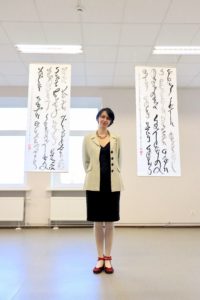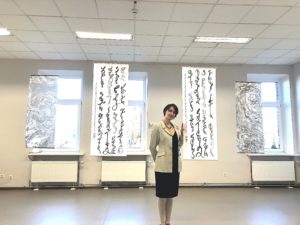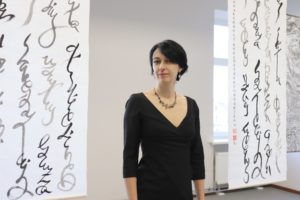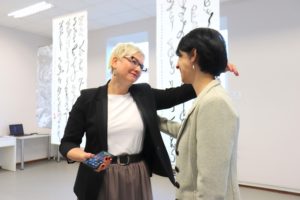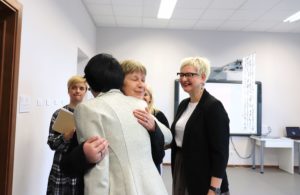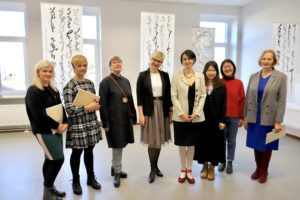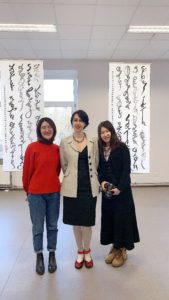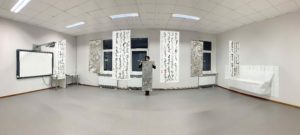An Exhibition Was Held by a Latvian Artist at Daugavpils University ——The Innovation of Combining Chinese Calligraphy and European Culture
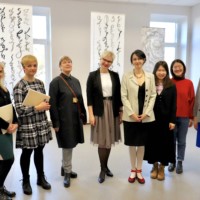
当地时间1月17日上午11时,白凯夏(Jekaterina Belajeva)“道加瓦河的抽象书法”毕业展在道加瓦皮尔斯大学举行。来自道加瓦皮尔斯大学音乐艺术学院的院长及部分师生和两位汉语教师参加了本次展览。
在展览开始前,两位汉语教师对白凯夏女士进行了一次采访。在采访中,白凯夏谈到自己开始学习中国画的原因。2009年,白凯夏受邀给年轻妈妈们开设艺术放松课程,同时教授孩子们画画。在这个过程中,她了解到中国书法和中国画的技艺。有着艺术底蕴的她觉得中国画所传达的丰富情感和积极向上的精神,与她的作画理念不谋而合,于是她开始对中国书法和中国画进行大量的尝试和研究。随着对中国画的认识逐渐深入,白凯夏不仅向俄罗斯画家Yulia Naumova学习中国画的作画技巧,而且还去往中国常德进修学习,进一步了解、学习中国画和中国书法。
谈到这次毕业展的创作灵感和理念,白凯夏说这是她在从里加去道加瓦皮尔斯的路上闪现的。当她看到熟悉亲切的道加瓦河,想到这条河连接着里加和道加瓦皮尔斯,于是她开始思考是否可以通过艺术作品把这一幕展示出来。经过大量的研究和朋友的帮助,她发现早在8-9世纪的中国,人们就创作出了“水画”,一直发展延续至今,许多著名的现代画派都受其影响,其中的一支分流便是“土耳其水拓画”,这在欧洲非常流行。于是,白凯夏就利用墨水、中国“水影画”的技术将道加瓦河画到了生宣纸上。她突破性地用了一种中国传统绘画艺术形式来表现拉脱维亚人民对道加瓦河的深厚感情。此外,她在作品中还以中国书法的草书形式来展示拉脱维亚文字,内容是由拉脱维亚著名诗人Jānis Rainis所创作的诗歌“Daugava”,并用中国汉字在旁注明。她表示,今后自己会以更多的中国书法形式来表现英语、法语、俄语等多种语言的文字。这是她创造的一种将中欧文化相结合的书法新技艺。道加瓦河是拉脱维亚人的母亲河,大家对“Daugava”耳熟能详,所以该作品更能引起大家的共鸣。另外,她特意选取了两枚别具心裁的印章,一枚刻着自己的中文名“白凯夏”,另一枚则是选用拉脱维亚传统符号“井,泉”,象征着福佑。最后,白凯夏表达了对拉脱维亚大学孔子学院两位院长及汉语教师们的感谢,帮助她更好地学习汉语和中国文化。
白凯夏女士即将从道加瓦皮尔斯大学研究生毕业,她想通过此次展览让更多人看到两种截然不同文化相结合的可能性,同时也希望更多的年轻人走进自然,接触艺术,感受文化。如今,白凯夏的飞笔工作室已经成立将近七年了,她的工作室也从刚开始的数人发展到现在上百个学生的规模,越来越多的拉脱维亚人前来学习西方画和中国画。她作为一名拉脱维亚艺术家,受到了中国书法和绘画技艺的影响,决心用一种传统的中国艺术形式展现道加瓦河、拉脱维亚文字和拉脱维亚的文化。
本次“道加瓦河的抽象书法”毕业展取得了圆满成功。道加瓦皮尔斯大学音乐艺术学院院长向大家说道:“白凯夏的毕业作品是国际化的,它们结合了拉脱维亚和中国的文化艺术。”她的艺术作品不仅增进了中拉两国传统友谊,也让更多的年轻人感受到艺术的魅力,是中拉文化交流传播的重要桥梁。
At 11 am local time on January 17th, the graduation exhibition of “The Calligraphic Abstractions of the Daugava River” by Bai Kaixia(Jekaterina Belajeva) was held at Daugavpils University. The dean from the Faculty of Music and Arts at Daugavpils University, some teachers and students, and two Chinese teachers participated in the exhibition.
Before the exhibition, two Chinese teachers conducted an interview with Ms.Bai Kaixia. During the interview, Bai Kaixia talked about why she started to learn Chinese painting. In 2009, Bai Kaixia was invited to provide art-relax courses for young mothers, and also to teach children to paint. In the process, she learned the skills of Chinese calligraphy and Chinese painting. With artistic background, she felt that the rich feelings and positive spirit conveyed by Chinese painting, which were coincided with her painting ideas, so she began to carry out a lot of research and attempts on Chinese calligraphy and Chinese painting. As her understanding of Chinese painting gradually deepened, Bai Kaixia not only learned the skills of Chinese painting from the Russian painter Yulia Naumova, but also went to Changde, China to have a further step to learn Chinese painting and Chinese calligraphy.
Speaking of the inspiration of the composition and ideas of this graduation exhibition, Bai Kaixia mentioned that it was her flash on the way from Riga to Daugavpils. When she saw the familiar and beloved Daugava River, thinking that this river has been being the connection of Riga and Daugavapils, she began to consider whether this scene could be displayed through art works. After a lot of research and with the help of her friends, she found that as early as the 8th-9th centuries in China, people created “water painting”, which has been continued to develop till today. Many famous modern art schools were influenced by it. One of the tributaries was the “Turkish water painting”, which was very popular in Europe. As a result, Bai Kaixia made use of the ink and the technology of Chinese “water painting” to paint the Daugava River onto shengxuan paper (raw rice paper). She has made a very big breakthrough to use a traditional Chinese painting art form to express the deep feelings of the Latvian people for the Daugava River. In addition, in her works, Latvian characters were displayed in cursive script form of Chinese calligraphy. The content was a poem “Daugava” written by the famous Latvian poet Jānis Rainis. She said that in the future, she would use more forms of Chinese calligraphy to show characters in English, French, Russian and other languages. This is a new calligraphy technique that she invented to combine Chinese and European culture. The Daugava River is the mother river of Latvian people. Everyone is very familiar with “Daugava” by having heard it many times, so this work can resonate with everyone. What’s more, she deliberately selected two unique seals, one was engraved with her own Chinese name “Bai Kaixia”, and the other one was a pattern of the traditional Latvian symbol “well, fountain” , which was to give blessings. In the end, Bai Kaixia gave her gratitude to the two directors of the Confucius Institute at University of Latvia and the Chinese teachers, helping her to learn Chinese and Chinese culture better.
Ms.Bai Kaixia is about to graduate from Daugavpils University. She hopes that through this exhibition, more people will see the possibility of combining two different cultures. Meanwhile, she also hopes that more young people can approach the nature, come into contact with the art, and feel the culture. Nowadays, The Flying Brush Studio has been established for nearly seven years, and it has also grown from a few people at the beginning to a scale of hundreds of students. More and more Latvian people have come to learn Western painting and Chinese painting. As a Latvian artist, Bai Kaixia has been influenced by Chinese calligraphy and painting skills. She was determined to show the Daugava River, Latvian script and Latvian culture in a traditional Chinese art form.
The graduation exhibition of “The Calligraphic Abstractions of the Daugava River” was a complete success. The dean of the Faculty of Music and Arts at Daugavpils University said, “Bai Kaixia’s works are international and they combine the culture and art of Latvia and China.” Her works not only promote the traditional friendship between China and Latvia, but also let more young people feel the charm of art, which is an important bridge for cultural exchanges and dissemination between China and Latvia.

